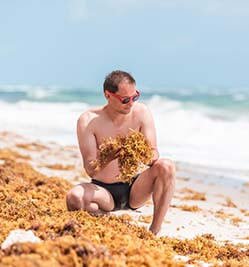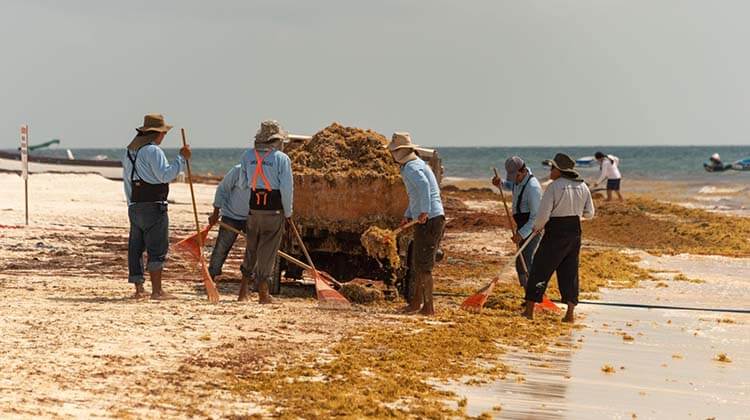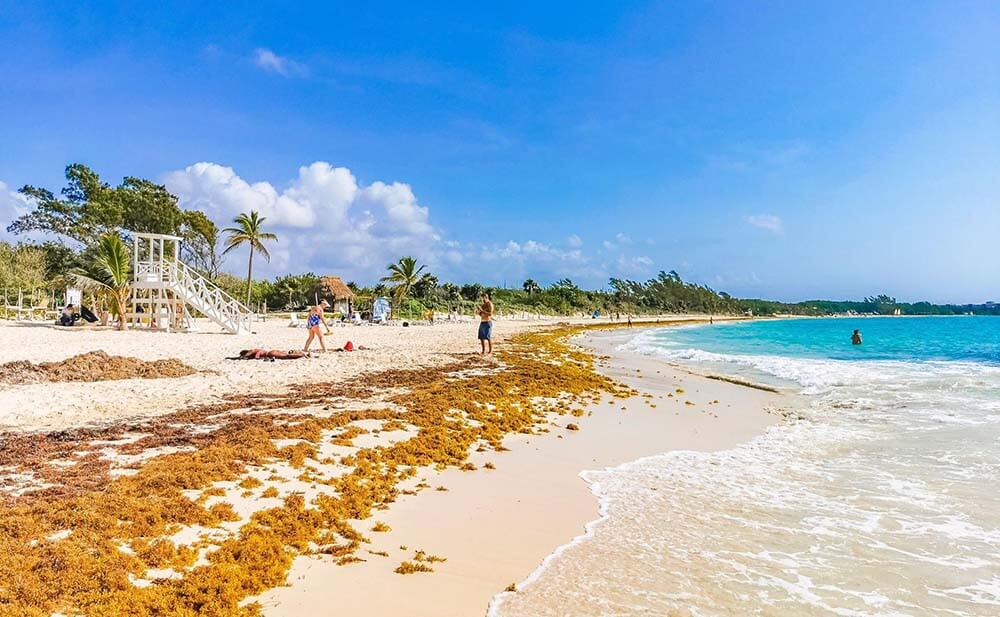We understand that sargassum seaweed has become a significant concern for Florida’s tourism industry. The invasion of this seaweed has raised fears that it could ruin the tourist season in the area, causing a big problem for the local economy.
The impact of this invasion is not only limited to Florida but also affects other coastlines around the Gulf of Mexico. This article aims to comprehensively understand the sargassum problem and its impact on the Environment, human health, and the local economy. We will also look at the factors that led to the sargassum crisis of 2023 and offer solutions to reduce its effects.
What is Sargassum?
Sargassum is a term that refers to more than 300 species of brown algae, with Sargassum natans and Sargassum fluitans being the two species most commonly found in the Atlantic.
This type of algae has its upsides when adrift at sea, providing food and protection for fishes, mammals, marine birds, crabs, and more.
It is also an essential habitat for endangered sea turtles called loggerheads and also serves as a nursery zone for a range of fish species that are important to commercialization like mahi-mahi, jacks, and amberjacks.
Impact of Sargassum on the Environment
 When seaweed hits the beaches, it can cause many environmental problems, such as emitting gas that can smell like rotten eggs. Seaweed can also be dangerous to human health.
When seaweed hits the beaches, it can cause many environmental problems, such as emitting gas that can smell like rotten eggs. Seaweed can also be dangerous to human health.
The gas that algae produce when they rot, called hydrogen sulfide, can be toxic and can trigger respiratory issues. Seaweed also has arsenic within its flesh, which makes it a risk if consumed or used to fertilize.
The swarms of algae that are left on beaches cost a lot of money to remove and can remove oxygen from the water, which can lead to dead zones.
These zones usually are nursery habitats for fisheries, and once they are devoid of oxygen, we lose that habitat.
The reasons behind what’s causing the 2023 Sargassum Problem
The proliferation of seaweed is influenced by environmental factors, influenced by changes in the nutrients as well as rainfall and wind conditions. Also, sea currents could alter the rate of growth of Sargassum and the extent to which it is accumulated.
The nitrogen and phosphorus that are found in the ocean can provide food for algae. Based on the Environmental Protection Agency, these elements can be released into the ocean by rivers, which accumulate concentrations of nitrogen and phosphorus due to human activities like farming and the production of fossil fuels.
The Impact of Sargassum on Florida’s Tourism Industry
The invasion of seaweed has become a significant concern for Florida’s tourism industry. The seaweed will likely be seen along beaches across Florida beginning in July according to the words of Dr. Brian Lapointe, a researcher at Florida Atlantic University’s Harbor Branch Oceanographic Institute.
The amount of seaweed can be “really a catastrophic problem,” Lapointe said to CNN‘s Rosemary Church, adding that it’s causing a huge problem for tourism in the Caribbean region in which it could pile over beaches that are 6 or 5 feet deep.
The impact of Sargassum on tourism in Florida cannot be overstated. The state’s economy largely depends heavily on the tourism industry, so the arrival of Sargassum can ruin the tourism season in the region.
Furthermore that the seaweed may form mounds that could be physically difficult to navigate. They also emit a gas that may be odorous like eggs that have been rotten. In the end, it can swiftly change into an issue for marine life.
The mounds of algae dumped on beaches also cost millions of dollars to clean up, leading to dead zones, which can destroy nursery habitats for fisheries.
The impact of this problem can lead to the loss of jobs, decreased revenue, and an overall negative effect on the economy. As sargassum seaweed piles up on beaches, it becomes physically difficult to navigate, emitting a gas that can smell like rotten eggs and threaten human health.
When people come into contact with Sargassum seaweed, it can cause skin irritation and a rash, especially for those with sensitive skin. This is due to the presence of histamines and other compounds in the seaweed that can cause an allergic reaction.
Additionally, decaying Sargassum can produce hydrogen sulfide gas, which can cause respiratory problems, headaches, and nausea. It is important to take precautions and avoid prolonged exposure to large amounts of Sargassum seaweed on beaches.
The gas, hydrogen sulfide, is harmful and may cause respiratory issues. Additionally, seaweed has arsenic, a toxic element in its flesh, which makes it hazardous if consumed or used as fertilizer.
The swarms of algae dumped on beaches can cost a lot of money to wash up and can also draw oxygen from the water, resulting in dead zones, usually used as nursery areas for fishing. Once these zones lack oxygen, we lose that habitat, threatening marine life.
Understanding Sargassum and Its Proliferation

Sargassum seaweed can be described as a kind of brown algae which refers to more than 300 species, with Sargassum Natans and Sargassum Fluitans as the two most frequently seen within the Atlantic.
While it provides food and protection for marine life when adrift at sea, it can cause many environmental problems once it hits the beaches. The Sargassum seaweed is likely to be present along beaches throughout Florida beginning in July, as per Dr. Brian Lapointe, a researcher at Florida Atlantic University’s Harbor Branch Oceanographic Institute.
This is an entirely new phenomenon in oceanography that has created this issue, and the seaweed population could be the largest ever recorded, stretching over 5 miles, stretching from Africa’s coast Africa up to the Gulf of Mexico.
The growth of seaweeds will fluctuate each year based on environmental factors, influenced by fluctuations in nutrients as well as rainfall and wind conditions. Additionally, the sea currents can alter Sargassum’s growth rate and how much it accumulates.
Nitrogen and phosphorus in the sea could provide food for algae. As per the Environmental Protection Agency, these elements can be disposed of into the ocean by rivers that gain levels of nitrogen and phosphorus through human activities, like the cultivation of fossil fuels and agriculture.
Sargassum Seaweed 2023 Forecast

Based on the current information, the forecast for sargassum seaweed in 2023 is unfavorable. The situation is particularly severe in South Florida, with the Florida Keys preparing for the worst in March 2023.
The Gulf Coast, including Florida, is expected to experience significant amounts of sargassum seaweed this summer. The sargassum season in 2023 began earlier than usual, starting in February, and is expected to increase as the temperature rises. This is due to the acceleration of the seaweed’s reproduction as the sea temperature rises with the warmer days ahead.
Impact on the Tourism Industry
Sargassum seaweed is a significant threat to Florida’s tourism industry, causing fears that it could ruin the tourist season in the area, leading to a big problem for the local economy.
The Caribbean region is already experiencing its devastating impact, where it can pile up on beaches up to 5 or 6 feet deep. The government, businesses, and other stakeholders must find ways to prevent or control the seaweed’s growth to avoid dead zones and protect marine habitats.
Raising awareness about this problem is also necessary for the public to understand the negative impact of Sargassum on the environment and human health.
Finding Effective Solutions
The government should invest in research to find effective ways to clean up the beaches and mitigate the problem. Some possible solutions include developing and using machines to collect and remove the seaweed from the beaches before it piles up.
These machines could also process the seaweed into a useful byproduct such as biofuel, reducing the need for fossil fuels and potentially creating new economic opportunities.
Additionally, finding ways to prevent the algae from blooming in the first place could reduce the need for clean-up efforts.
This could include reducing the amount of phosphorus and nitrogen that enters the ocean from rivers and identifying and mitigating other ecological factors that contribute to the seaweed’s proliferation.
In conclusion, sargassum seaweed is a serious issue that poses a significant threat to the environment and the tourism industry. Therefore, it is vital to create awareness of the negative effects of Sargassum on the environment as well as human health.
The government, businesses, and other stakeholders must work together to find practical solutions to prevent or control the growth of Sargassum seaweed. This means investing in research that will help us know the causes and consequences of seaweed blooms and developing strategies to limit their impact on the natural environment and local communities.
One approach is to address the sources of nutrients that contribute to the growth of Sargassum, such as agricultural runoff and fossil fuel production. This could involve stricter regulations on these industries and increased investment in sustainable practices that reduce their environmental impact.
Another strategy is to develop new technologies and methods for removing Sargassum from beaches and coastal areas. This could include the use of specialized machinery or the development of new biodegradable materials that can safely break down the seaweed without harming the surrounding ecosystem.
In addition, public awareness and education are essential in addressing the Sargassum problem. By raising awareness about the negative impact of seaweed on the environment and local economies, we can encourage individuals and businesses to take action to prevent its growth and spread.




